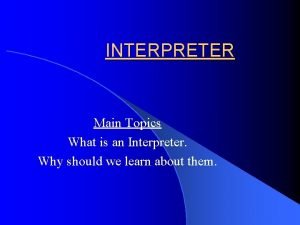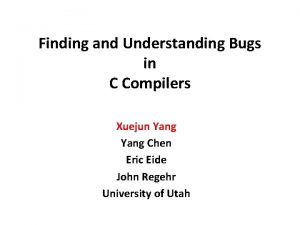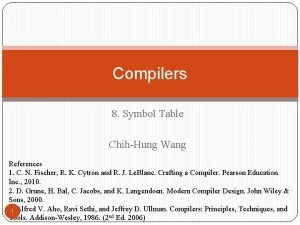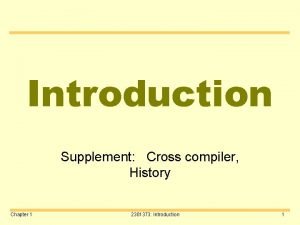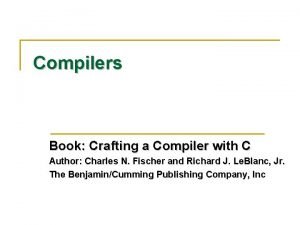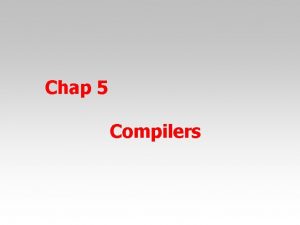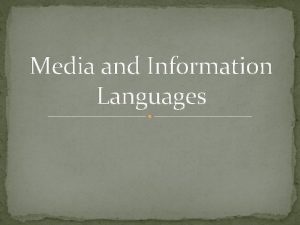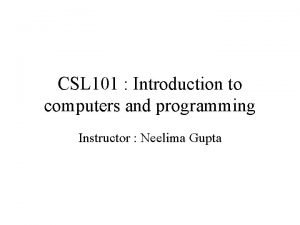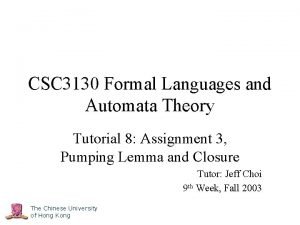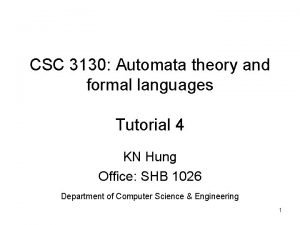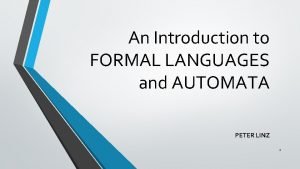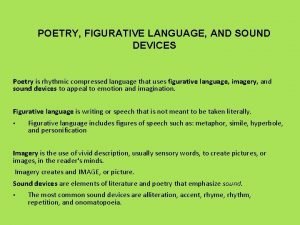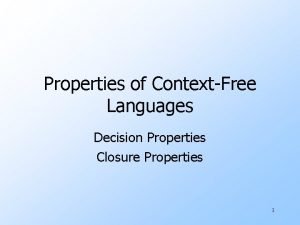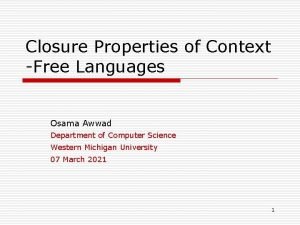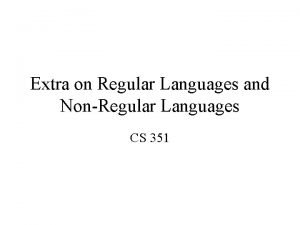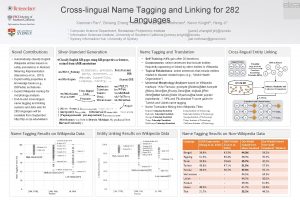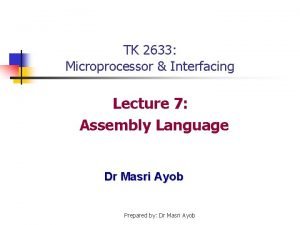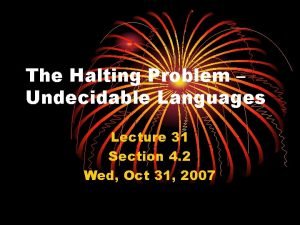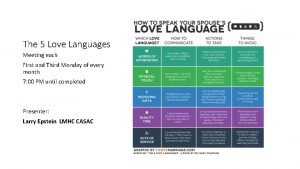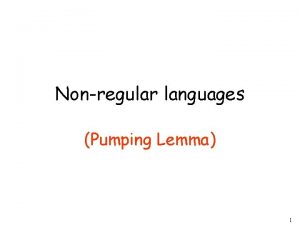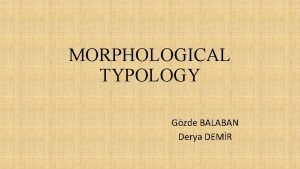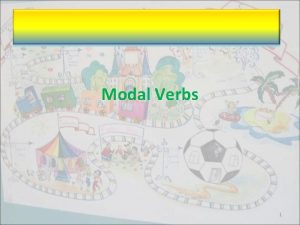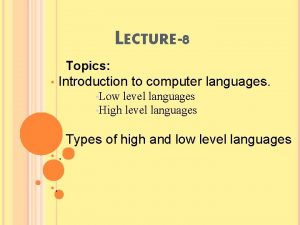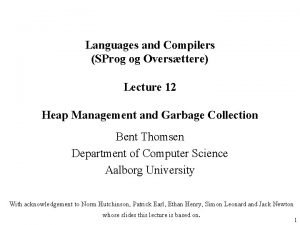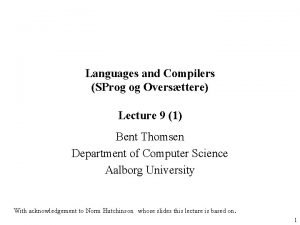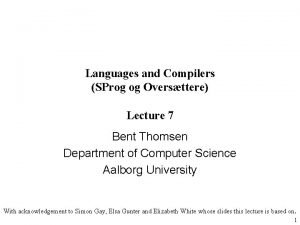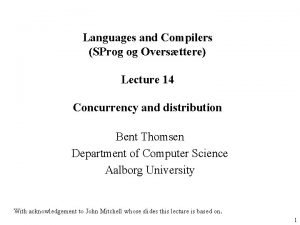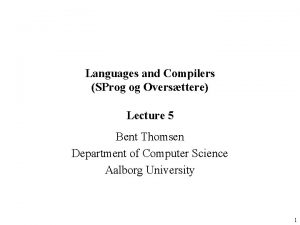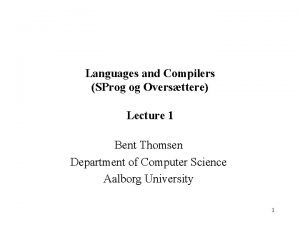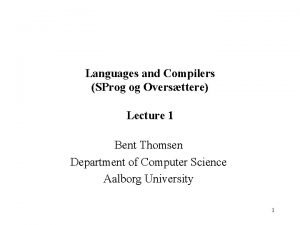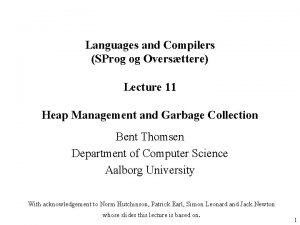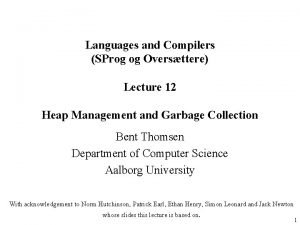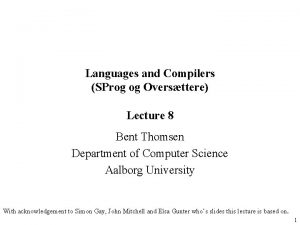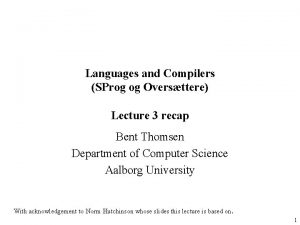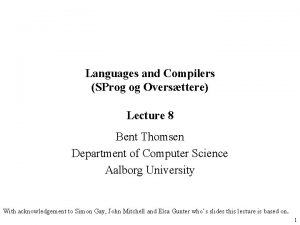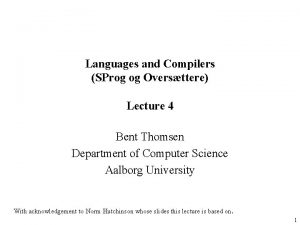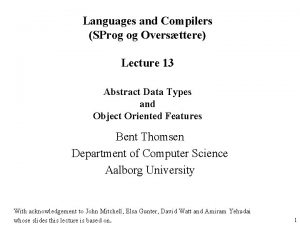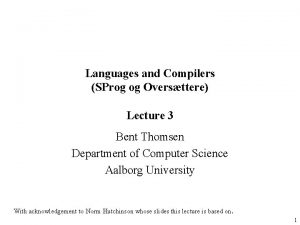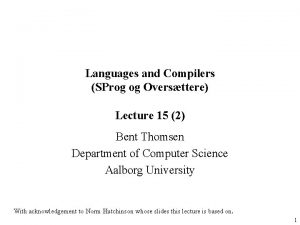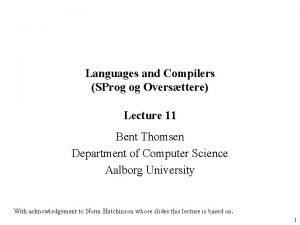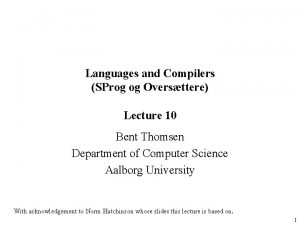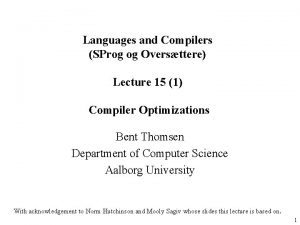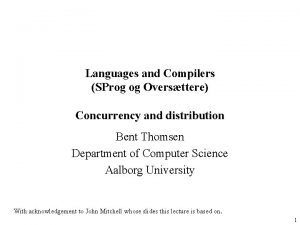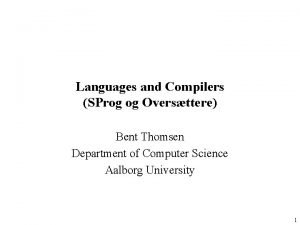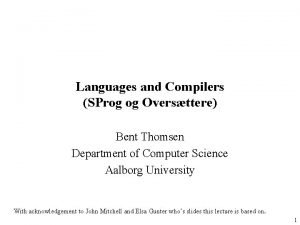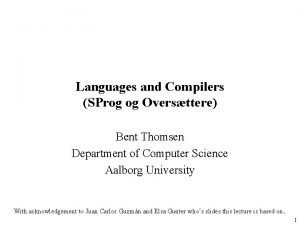Languages and Compilers SProg og Oversttere Lecture 2



















































































- Slides: 83

Languages and Compilers (SProg og Oversættere) Lecture 2 Bent Thomsen Department of Computer Science Aalborg University With acknowledgement to Norm Hutchinson whose slides this lecture is based on. 1

Today’s lecture • Three topics – Treating Compilers and Interpreters as black-boxes • Tombstone- or T- diagrams – A first look inside the black-box • Your guided tour – Some Language Design Issues 2

Terminology Q: Which programming languages play a role in this picture? input source program Translator is expressed in the source language output object program is expressed in the target language is expressed in the implementation language A: All of them! 3

Tombstone Diagrams What are they? – diagrams consisting out of a set of “puzzle pieces” we can use to reason about language processors and programs – different kinds of pieces – combination rules (not all diagrams are “well formed”) Program P implemented in L P L Machine implemented in hardware M Translator implemented in L S -> T L Language interpreter in L M L 4

Tombstone diagrams: Combination rules P M M P L M OK! P S S -> T M M OK! WRONG! P L WRONG! P T OK! S -> T M 5

Compilation Example: Compilation of C programs on an x 86 machine Tetris C C -> x 86 Tetris x 86 6

Cross compilation Example: A C “cross compiler” from x 86 to PPC A cross compiler is a compiler which runs on one machine (the host machine) but emits code for another machine (the target machine). Tetris C C -> PPC x 86 Tetris PPC download Tetris PPC Host ≠ Target Q: Are cross compilers useful? Why would/could we use them? 8

Two Stage Compilation A two-stage translator is a composition of two translators. The output of the first translator is provided as input to the second translator. Tetris Java->JVM JVM->x 86 x 86 9

Compiling a Compiler Observation: A compiler is a program! Therefore it can be provided as input to a language processor. Example: compiling a compiler. Java->x 86 C -> x 86 C x 86 10

Interpreters An interpreter is a language processor implemented in software, i. e. as a program. Terminology: abstract (or virtual) machine versus real machine Example: The Java Virtual Machine Tetris JVM x 86 Q: Why are abstract machines useful? 11

Interpreters Q: Why are abstract machines useful? 1) Abstract machines provide better platform independence Tetris JVM x 86 Tetris JVM PPC 12

Interpreters Q: Why are abstract machines useful? 2) Abstract machines are useful for testing and debugging. Example: Testing the “Ultima” processor using hardware emulation P Ultima x 86 P Ultima Functional equivalence Note: we don’t have to implement Ultima emulator in x 86 we can use a high-level language and compile it. 13

Interpreters versus Compilers Q: What are the tradeoffs between compilation and interpretation? Compilers typically offer more advantages when – programs are deployed in a production setting – programs are “repetitive” – the instructions of the programming language are complex Interpreters typically are a better choice when – – we are in a development/testing/debugging stage programs are run once and then discarded the instructions of the language are simple the execution speed is overshadowed by other factors • e. g. on a web server where communications costs are much higher than execution speed 14

Interpretive Compilers Why? A tradeoff between fast(er) compilation and a reasonable runtime performance. How? Use an “intermediate language” • more high-level than machine code => easier to compile to • more low-level than source language => easy to implement as an interpreter Example: A “Java Development Kit” for machine M Java->JVM M 15

Interpretive Compilers Example: Here is how we use our “Java Development Kit” to run a Java program P P Java javac P Java->JVM M M java P JVM M M 16

Portable Compilers Example: Two different “Java Development Kits” Kit 1: Java->JVM M Kit 2: Java->JVM JVM M Q: Which one is “more portable”? 17

Portable Compilers In the previous example we have seen that portability is not an “all or nothing” kind of deal. It is useful to talk about a “degree of portability” as the percentage of code that needs to be re-written when moving to a different machine. In practice 100% portability is as good as impossible. 18

Example: a “portable” compiler kit Portable Compiler Kit: Java->JVM Java Q: Suppose we want to run this kit on some machine M. How could we go about realizing that goal? (with the least amount of effort) 19

Example: a “portable” compiler kit Java->JVM Java Q: Suppose we want to run this kit on some machine M. How could we go about realizing that goal? (with the least amount of effort) JVM Java reimplement JVM C C->M JVM M 20

Example: a “portable” compiler kit This is what we have now: Java->JVM Java JVM M Now, how do we run our Tetris program? Tetris Java->JVM JVM M M Tetris JVM M M 21

Bootstrapping Remember our “portable compiler kit”: Java->JVM Java JVM M We haven’t used this yet! Java->JVM Java Same language! Q: What can we do with a compiler written in itself? Is that useful at all? 22

Bootstrapping Java->JVM Java Same language! Q: What can we do with a compiler written in itself? Is that useful at all? • By implementing the compiler in (a subset of) its own language, we become less dependent on the target platform => more portable implementation. • But… “chicken and egg problem”? How do to get around that? => BOOTSTRAPPING: requires some work to make the first “egg”. There are many possible variations on how to bootstrap a compiler written in its own language. 23

Bootstrapping an Interpretive Compiler to Generate M code Our “portable compiler kit”: Java->JVM Java JVM M Goal: we want to get a “completely native” Java compiler on machine M P P Java->M Java M M M 24

Bootstrapping an Interpretive Compiler to Generate M code (first approach) Step 1: implement Java ->M Java by rewriting Java ->JVM Java Step 2: compile it Java->M Java->JVM JVM M M Step 3: Use this to compile again 25

Bootstrapping an Interpretive Compiler to Generate M code (first approach) Step 3: “Self compile” the Java (in Java) compiler Java->M Java M JVM M M This is our desired compiler! Step 4: use this to compile the P program P Java->M P M M 26

Bootstrapping an Interpretive Compiler to Generate M code (second approach) Idea: we will build a two-stage Java -> M compiler. P Java->JVM M M M We will make this by compiling Java->JVM JVM->M M M P M To get this we implement JVM->M Java and compile it 27

Bootstrapping an Interpretive Compiler to Generate M code (second approach) Step 1: implement JVM->M Java Step 2: compile it JVM->M Java->JVM JVM M M Step 3: compile this 28

Bootstrapping an Interpretive Compiler to Generate M code (second approach) Step 3: “Self compile” the JVM (in JVM) compiler JVM->M M JVM M M This is the second stage of our compiler! Step 4: use this to compile the Java compiler 29

Bootstrapping an Interpretive Compiler to Generate M code Step 4: Compile the Java->JVM compiler into machine code Java->JVM JVM->M M The first stage of our compiler! We are DONE! P Java->JVM M M M JVM->M P M M M 30

Full Bootstrap A full bootstrap is necessary when we are building a new compiler from scratch. Example: We want to implement an Ada compiler for machine M. We don’t currently have access to any Ada compiler (not on M, nor on any other machine). Idea: Ada is very large, we will implement the compiler in a subset of Ada and bootstrap it from a subset-of-Ada compiler in another language. (e. g. C) v 1 Step 1: build a compiler for Ada-S ->M in another language C 31

Full Bootstrap Step 1 a: build a compiler (v 1) for Ada-S in another language. v 1 Ada-S ->M C Step 1 b: Compile v 1 compiler on M v 1 Ada-S ->M Ada-S->M C M M This compiler can be used for M bootstrapping on machine M but we do not want to rely on it permanently! 32

Full Bootstrap Step 2 a: Implement v 2 of Ada-S compiler in Ada-S v 2 Ada-S ->M Q: Is it hard to rewrite the compiler in Ada-S? Ada-S Step 2 b: Compile v 2 compiler with v 1 compiler v 2 v 1 Ada-S->M Ada-S ->M M M We are now no longer dependent on the availability of a C compiler! 33

Full Bootstrap Step 3 a: Build a full Ada compiler in Ada-S v 3 Ada->M Ada-S Step 3 b: Compile with v 2 compiler v 3 Ada->M v 2 Ada->M M Ada-S ->M M M From this point on we can maintain the compiler in Ada. Subsequent versions v 4, v 5, . . . of the compiler can be written in Ada and each compiled with the previous version. 34

Half Bootstrap We discussed full bootstrap which is required when we have no access to a compiler for our language at all. Q: What if we have access to a compiler for our language on a different machine HM but want to develop one for TM ? We have: Ada->HM HM Ada->HM Ada We want: Ada->TM TM Idea: We can use cross compilation from HM to TM to bootstrap the TM compiler. 35

Half Bootstrap Idea: We can use cross compilation from HM to bootstrap the M compiler. Step 1: Implement Ada->TM compiler in Ada->TM Ada Step 2: Compile on HM Ada->TM Ada->HM HM Cross compiler: running on HM but emits TM code 36

Half Bootstrap Step 3: Cross compile our TM compiler. Ada->TM TM HM HM DONE! From now on we can develop subsequent versions of the compiler completely on TM 37

Bootstrapping to Improve Efficiency The efficiency of programs and compilers: Efficiency of programs: - memory usage - runtime Efficiency of compilers: - Efficiency of the compiler itself - Efficiency of the emitted code Idea: We start from a simple compiler (generating inefficient code) and develop more sophisticated versions of it. We can then use bootstrapping to improve performance of the compiler. 38

Bootstrapping to Improve Efficiency We have: Ada->Mslow Ada-> Mslow Ada Step 1 We implement: Ada->Mfast Ada-> Mslow M Step 2 Ada->Mfast Ada-> Mfast Mslow Fast compiler that emits fast code! M 39

Conclusion • • • To write a good compiler you may be writing several simpler ones first You have to think about the source language, the target language and the implementation language. Strategies for implementing a compiler 1. Write it in machine code 2. Write it in a lower level language and compile it using an existing compiler 3. Write it in the same language that it compiles and bootstrap • The work of a compiler writer is never finished, there is always version 1. x and version 2. 0 and … 40

Compilation So far we have treated language processors (including compilers) as “black boxes” Now we take a first look "inside the box": how are compilers built. And we take a look at the different “phases” and their relationships 41

The “Phases” of a Compiler Source Program Syntax Analysis Error Reports Abstract Syntax Tree Contextual Analysis Error Reports Decorated Abstract Syntax Tree Code Generation Object Code 42

Different Phases of a Compiler The different phases can be seen as different transformation steps to transform source code into object code. The different phases correspond roughly to the different parts of the language specification: • Syntax analysis <-> Syntax • Contextual analysis <-> Contextual constraints • Code generation <-> Semantics 43

Mini Triangle is a very simple Pascal-like programming language. An example program: !This is a comment. let const m ~ 7; var n in begin n : = 2 * m putint(n) end Declarations Expression Command ; 44

Syntax of Mini Triangle Program : : = single-Command : : = V-name : = Expression | Identifier ( Expression ) | if Expression then single-Command else single-Command | while Expression do single-Command | let Declaration in single-Command | begin Command end Command : : = single-Command | Command ; single-Command 45

Syntax of Mini Triangle (continued) Expression : : = primary-Expression | Expression Operator primary-Expression : : = Integer-Literal | V-name | Operator primary-Expression | ( Expression ) V-name : : = Identifier : : = Letter | Identifier Digit Integer-Literal : : = Digit | Integer-Literal Digit Operator : : = + | - | * | / | < | > | = 46

Syntax of Mini Triangle (continued) Declaration : : = single-Declaration | Declaration ; single-Declaration : : = const Identifier ~ Expression | var Identifier : Type-denoter : : = Identifier Comment : : = ! Comment. Line eol Comment. Line : : = Graphic Comment. Line Graphic : : = any printable character or space 47

Syntax Trees A syntax tree is an ordered labeled tree such that: a) terminal nodes (leaf nodes) are labeled by terminal symbols b) non-terminal nodes (internal nodes) are labeled by non terminal symbols. c) each non-terminal node labeled by N has children X 1, X 2, . . . Xn (in this order) such that N : = X 1, X 2, . . . Xn is a production. 48

Syntax Trees Example: 1 2 3 Expression : : = Expression Op primary-Exp Expression 1 Expression 3 primary-Exp. V-name Ident d primary-Exp. V-name 2 Op Int-Lit Op + 10 * Ident d 49

Concrete and Abstract Syntax The previous grammar specified the concrete syntax of Mini Triangle. The concrete syntax is important for the programmer who needs to know exactly how to write syntactically wellformed programs. The abstract syntax omits irrelevant syntactic details and only specifies the essential structure of programs. Example: different concrete syntaxes for an assignment v : = e (set! v e) e -> v v = e 50

Concrete Syntax of Commands single-Command : : = V-name : = Expression | Identifier ( Expression ) | if Expression then single-Command else single-Command | while Expression do single-Command | let Declaration in single-Command | begin Command end Command : : = single-Command | Command ; single-Command 51

Abstract Syntax of Commands Command : : = V-name : = Expression Assign. Cmd | Identifier ( Expression ) | if Expression then Command else Command | while Expression do Command | let Declaration in Command | Command ; Command Call. Cmd If. Cmd While. Cmd Let. Cmd Sequential. Cmd 52

Concrete Syntax of Expressions (recap) Expression : : = primary-Expression | Expression Operator primary-Expression : : = Integer-Literal | V-name | Operator primary-Expression | ( Expression ) V-name : : = Identifier 53

Abstract Syntax of Expressions Expression : : = Integer-Literal Integer. Exp | V-name Vname. Exp | Operator Expression Unary. Exp | Expression Op Expression Binary. Exp V-name: : = Identifier Simple. VName 54

Abstract Syntax Trees Abstract Syntax Tree for: d: =d+10*n Assignment. Cmd Binary. Expression VName. Exp Simple. VName Ident d Integer. Exp VName. Exp Simple. VName Op Int-Lit + 10 Op * Ident n 55

1) Syntax Analysis Source Program Syntax Analysis Error Reports Abstract Syntax Tree Note: Not all compilers construct an explicit representation of an AST. (e. g. on a “single pass compiler” generally no need to construct an AST) 56

Example Program We now look at each of the three different phases in a little more detail. We look at each of the steps in transforming an example Mini Triangle program into TAM code. ! This program is useless except for ! illustration let var n: integer; var c: char in begin c : = ‘&’; n : = n+1 end 57

1) Syntax Analysis -> AST Program Let. Command Sequential. Declaration Assign. Command Var. Decl Simple. T Ident n Ident Integer Char. Expr Binary. Expr VName. Exp Int. Expr Simple. T Simple. V Ident c Char Simple. V Ident Char. Lit Ident c ‘&’ n Ident Op Int. Lit n + 1 58

2) Contextual Analysis -> Decorated AST Abstract Syntax Tree Contextual Analysis Error Reports Decorated Abstract Syntax Tree Contextual analysis: • Scope checking: verify that all applied occurrences of identifiers are declared • Type checking: verify that all operations in the program are used according to their type rules. Annotate AST: • Applied identifier occurrences => declaration • Expressions => Type 59

2) Contextual Analysis -> Decorated AST Program Let. Command Sequential. Declaration Assign. Command Binary. Expr : int Assign. Command Var. Decl Simple. T Ident n Integer Char. Expr : char VName. Exp Int. Expr : int Simple. T Simple. V : char Ident c Char : int Ident Char. Lit Ident c ‘&’ : int n Ident Op Int. Lit n + 1 60

Contextual Analysis Finds scope and type errors. Example 1: Assign. Command : int ***TYPE ERROR (incompatible types in assigncommand) : char Example 2: foo not found Simple. V ***SCOPE ERROR: undeclared variable foo Ident foo 61

3) Code Generation Decorated Abstract Syntax Tree Code Generation Object Code • Assumes that program has been thoroughly checked and is well formed (scope & type rules) • Takes into account semantics of the source language as well as the target language. • Transforms source program into target code. 62

3) Code Generation let var n: integer; var c: char in begin c : = ‘&’; n : = n+1 end Var. Decl address = 0[SB] PUSH 2 LOADL 38 STORE 1[SB] LOAD 0 LOADL 1 CALL add STORE 0[SB] POP 2 HALT Simple. T Ident n Integer 63

Compiler Passes • A pass is a complete traversal of the source program, or a complete traversal of some internal representation of the source program. • A pass can correspond to a “phase” but it does not have to! • Sometimes a single “pass” corresponds to several phases that are interleaved in time. • What and how many passes a compiler does over the source program is an important design decision. 64

Single Pass Compiler A single pass compiler makes a single pass over the source text, parsing, analyzing and generating code all at once. Dependency diagram of a typical Single Pass Compiler: Compiler Driver calls Syntactic Analyzer calls Contextual Analyzer calls Code Generator 65

Multi Pass Compiler A multi pass compiler makes several passes over the program. The output of a preceding phase is stored in a data structure and used by subsequent phases. Dependency diagram of a typical Multi Pass Compiler: Compiler Driver calls Syntactic Analyzer Contextual Analyzer Code Generator input output Source Text AST Decorated AST Object Code 66

The Mini Triangle Compiler Driver public class Compiler { public static void compile. Program(. . . ) { Parser parser = new Parser(. . . ); Checker checker = new Checker(. . . ); Encoder generator = new Encoder(. . . ); Program the. AST = parser. parse(); checker. check(the. AST); generator. encode(the. AST); } public void main(String[] args) {. . . compile. Program(. . . ). . . } } 67

Compiler Design Issues Single Pass Multi Pass Speed better worse Memory Modularity better for large programs worse (potentially) better for small programs better Flexibility worse better “Global” optimization impossible Source Language single pass compilers are not possible for many programming languages 68

Language Issues Example Pascal: Pascal was explicitly designed to be easy to implement with a single pass compiler: – Every identifier must be declared before it is first used. ? var n: integer; procedure inc; begin n: =n+1 end; Undeclared Variable! var n: integer; 69

Language Issues Example Pascal: – Every identifier must be declared before it is used. – How to handle mutual recursion then? procedure ping(x: integer) begin. . . pong(x-1); . . . end; procedure pong(x: integer) begin. . . ping(x); . . . end; 70

Language Issues Example Pascal: – Every identifier must be declared before it is used. – How to handle mutual recursion then? forward procedure pong(x: integer) procedure ping(x: integer) begin. . . pong(x-1); . . . end; OK! procedure pong(x: integer) begin. . . ping(x); . . . end; 71

Language Issues Example Java: – identifiers can be declared before they are used. – thus a Java compiler needs at least two passes Class Example { void inc() { n = n + 1; } int n; void use() { n = 0 ; inc(); } } 72

Scope of Variable • Range of program that can reference that variable (ie access the corresponding data object by the variable’s name) • Variable is local to program or block if it is declared there • Variable is non-local to program unit if it is visible there but not declared there 73

Static vs. Dynamic Scope • Under static, sometimes called lexical, scope, sub 1 will always reference the x defined in big • Under dynamic scope, the x it references depends on the dynamic state of execution procedure big; var x: integer; procedure sub 1; begin {sub 1}. . . x. . . end; {sub 1} procedure sub 2; var x: integer; begin {sub 2}. . . sub 1; . . . end; {sub 2} begin {big}. . . sub 1; sub 2; . . . end; {big} 74

Static Scoping • Scope computed at compile time, based on program text • To determine the name of a used variable we must find statement declaring variable • Subprograms and blocks generate hierarchy of scopes – Subprogram or block that declares current subprogram or contains current block is its static parent • General procedure to find declaration: – First see if variable is local; if yes, done – If non-local to current subprogram or block recursively search static parent until declaration is found – If no declaration is found this way, undeclared variable error detected 75

Example program main; var x : integer; procedure sub 1; var x : integer; begin { sub 1 } … x … end; { sub 1 } begin { main } … x … end; { main } 76

Dynamic Scope • Now generally thought to have been a mistake • Main example of use: original versions of LISP – Scheme uses static scope – Perl allows variables to be declared to have dynamic scope • Determined by the calling sequence of program units, not static layout • Name bound to corresponding variable most recently declared among still active subprograms and blocks 77

Example program main; var x : integer; procedure sub 1; begin { sub 1 } … x … end; { sub 1 } procedure sub 2; var x : integer; begin { sub 2 } … call sub 1 … end; { sub 2 } … call sub 2… end; { main } 78

Binding • Binding: an association between an attribute and its entity • Binding Time: when does it happen? • … and, when can it happen? 79

Binding of Data Objects and Variables • Attributes of data objects and variables have different binding times • If a binding is made before run time and remains fixed through execution, it is called static • If the binding first occurs or can change during execution, it is called dynamic 80

Binding Time Static • Language definition time • Language implementation time • Program writing time • Compile time • Link time • Load time Dynamic • Run time – At the start of execution (program) – On entry to a subprogram or block – When the expression is evaluated – When the data is accessed 81

X = X + 10 • • • Set of types for variable X Type of variable X Set of possible values for variable X Value of variable X Scope of X – lexical or dynamic scope • Representation of constant 10 – Value (10) – Value representation (10102) • big-endian vs. little-endian – Type (int) – Storage (4 bytes) • stack or global allocation • Properties of the operator + – Overloaded or not 82

Little- vs. Big-Endians • Big-endian – A computer architecture in which, within a given multi-byte numeric representation, the most significant byte has the lowest address (the word is stored `big-end-first'). – Motorola and Sun processors • Little-endian – a computer architecture in which, within a given 16 - or 32 -bit word, bytes at lower addresses have lower significance (the word is stored `little-end-first'). – Intel processors from The Jargon Dictionary - http: //info. astrian. net/jargon 83

Binding Times summary • Language definition time: – language syntax and semantics, scope discipline • Language implementation time: – interpreter versus compiler, – aspects left flexible in definition, – set of available libraries • Compile time: – some initial data layout, internal data structures • Link time (load time): – binding of values to identifiers across program modules • Run time (execution time): – actual values assigned to non-constant identifiers The Programming language designer and compiler implementer have to make decisions about binding times 84
 Cs 421 programming languages and compilers
Cs 421 programming languages and compilers Cs 421 uiuc
Cs 421 uiuc Motorik og sprog
Motorik og sprog Cicero pentagram
Cicero pentagram Hjemmeside layout dansk
Hjemmeside layout dansk Analyse af det røde gardin
Analyse af det røde gardin What is an interpreter
What is an interpreter Finding and understanding bugs in c compilers
Finding and understanding bugs in c compilers Lex leblanc
Lex leblanc Advantage and disadvantage of compiler and interpreter
Advantage and disadvantage of compiler and interpreter Binarymove compilers
Binarymove compilers Cousins of compiler
Cousins of compiler Crafting a compiler
Crafting a compiler Basic compiler functions in system software
Basic compiler functions in system software Front-end and back-end of compiler
Front-end and back-end of compiler 01:640:244 lecture notes - lecture 15: plat, idah, farad
01:640:244 lecture notes - lecture 15: plat, idah, farad Real-time systems and programming languages
Real-time systems and programming languages Modern languages for life and work
Modern languages for life and work Aural language in media
Aural language in media Latin and romance languages
Latin and romance languages Defence centre for languages and culture
Defence centre for languages and culture Strongly typed vs weakly typed
Strongly typed vs weakly typed Data mining primitives languages and system architecture
Data mining primitives languages and system architecture Mil media and information languages
Mil media and information languages Csci 3130
Csci 3130 Automata theory tutorial
Automata theory tutorial Cyk algorithm
Cyk algorithm Advantages of application software
Advantages of application software Nondeterministic means choice of moves for automata *
Nondeterministic means choice of moves for automata * Sound devices figure of speech
Sound devices figure of speech Cyk algorithm
Cyk algorithm Csci 3130
Csci 3130 Real time programming language
Real time programming language Decision properties of cfl
Decision properties of cfl Closure property of context free language
Closure property of context free language Regular and irregular languages
Regular and irregular languages Translators and facilities of languages
Translators and facilities of languages School of languages cultures and societies
School of languages cultures and societies Data mining languages and system architecture
Data mining languages and system architecture Boliang zhang
Boliang zhang Electricity and magnetism lecture notes
Electricity and magnetism lecture notes Power system dynamics and stability lecture notes
Power system dynamics and stability lecture notes Microbial physiology lecture notes
Microbial physiology lecture notes Limits fits and tolerances
Limits fits and tolerances Cloud computing lecture
Cloud computing lecture 40h11 tolerance
40h11 tolerance Financial markets and institutions ppt
Financial markets and institutions ppt Indirect finance
Indirect finance Extempore and lecture
Extempore and lecture Utilities and energy lectures
Utilities and energy lectures Catherine belsey books
Catherine belsey books Mechatronics notes ppt
Mechatronics notes ppt Vct monitoring foetal
Vct monitoring foetal Lecture on love courtship and marriage
Lecture on love courtship and marriage Power system dynamics and stability lecture notes
Power system dynamics and stability lecture notes Project planning and management lecture notes ppt
Project planning and management lecture notes ppt Femoral triangle
Femoral triangle Why do individual languages vary among places?
Why do individual languages vary among places? What is assembler
What is assembler Jumlah level dalam gambar ini adalah . . . .
Jumlah level dalam gambar ini adalah . . . . Turing unrecognizable languages
Turing unrecognizable languages Christian love language test
Christian love language test 5 love languages test
5 love languages test Love language test
Love language test Love language categories
Love language categories 11 official languages of south africa
11 official languages of south africa How many languages are there
How many languages are there Ror programming language
Ror programming language What languages come from latin
What languages come from latin Relational query languages in dbms
Relational query languages in dbms Introduction to scripting languages
Introduction to scripting languages Multithreaded programming languages
Multithreaded programming languages Pumping lemma non regular languages examples
Pumping lemma non regular languages examples Akwa ibom state
Akwa ibom state New zealand official languages english
New zealand official languages english Derya balaban
Derya balaban Carol can speak three foreign languages
Carol can speak three foreign languages Love language questions
Love language questions Low-level programming language
Low-level programming language Asian languages written
Asian languages written Five love languages.com
Five love languages.com Programming languages levels
Programming languages levels Introduction to programming languages
Introduction to programming languages Sino-tibetan languages
Sino-tibetan languages






